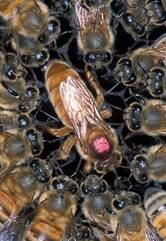The sight of swarming bees can alarm just about anyone, but it is a normal life cycle of honey bees.
At the end of winter there are fewer bees in the colony than there were during the summer, you have the queen and a lot of workers that huddled together in a winter cluster to keep warm.
As spring begins, the colony expands as more workers are produced. There may be several thousand workers busily foraging, regulating the temperature in the hive, guarding the colony, tending to the brood, feeding each other, cleaning, creating wax combs and honey while all communicating with pheromones through food sharing called trophallaxis. But, when the colony becomes too big, the queens’ pheromones don’t reach all the workers.
The workers that are not receiving the queens pheromones panic and they create a new queen - but there isn’t room for two queens. The old queen becomes aware of this mutiny so before the new queen emerges, she takes off with part of the colony to establish a new nest. Before leaving, the mutineers fill up with as much nectar as they can consume.
When the old queen and her workers leave, they swarm in a large mass, but the queen is not a strong flyer and needs to rest at some point- be it on a branch, post or fence. The worker bees will swarm around the queen as she rests while scout bees are out looking for a new location for the colony to live. Depending on how quickly the scout bees find a suitable new home, the swarm will remain there for as long as a day or more.
Go Green Pest Control owner Randy Bilesky is a long-time South Delta resident. Trained and certified, Bilesky has first-hand knowledge of the pest problems that local homeowners and business owners encounter.


